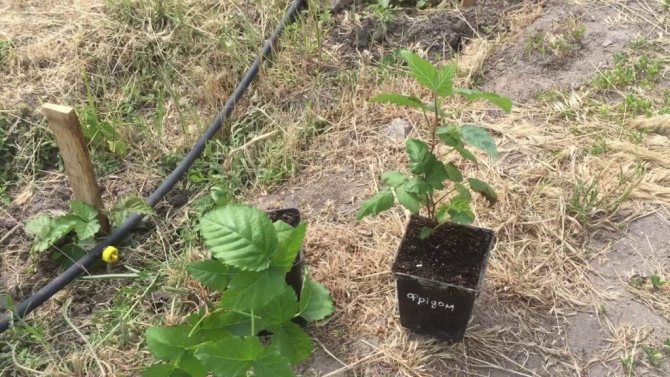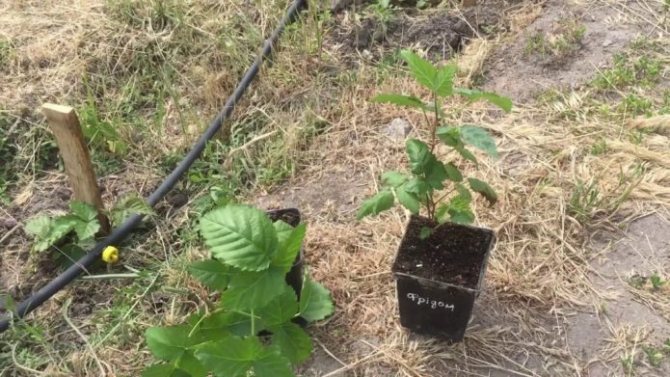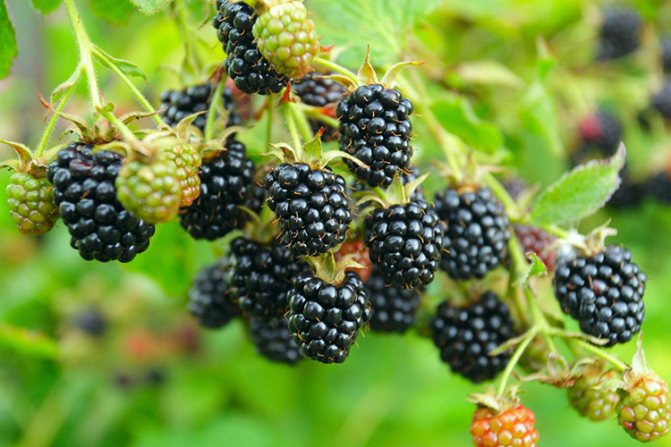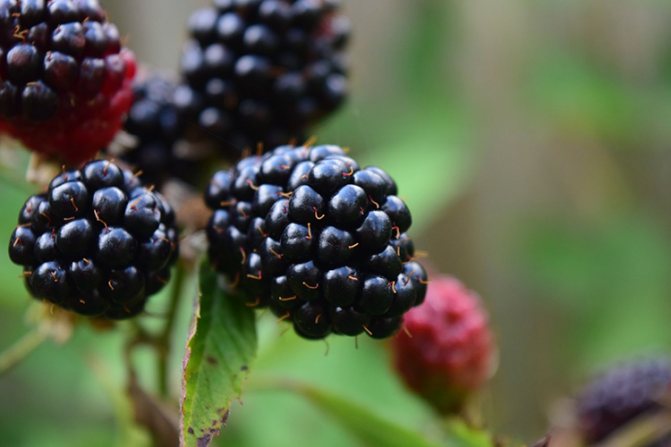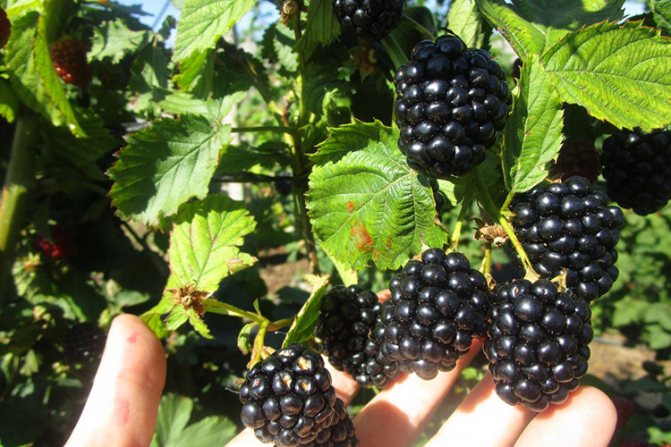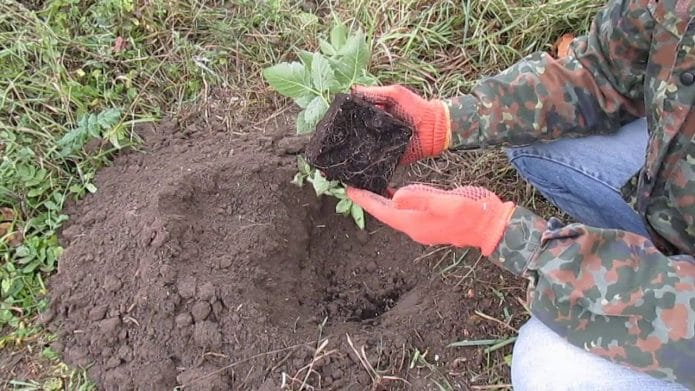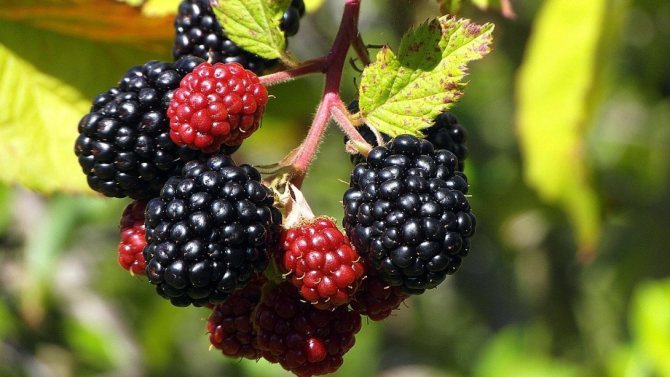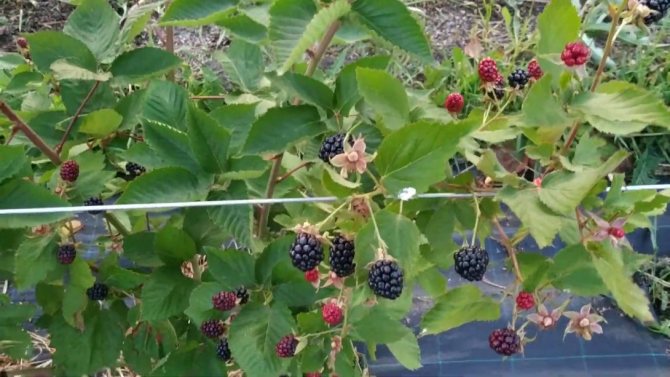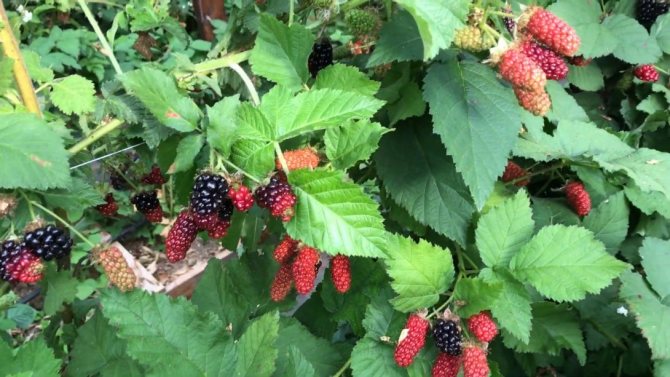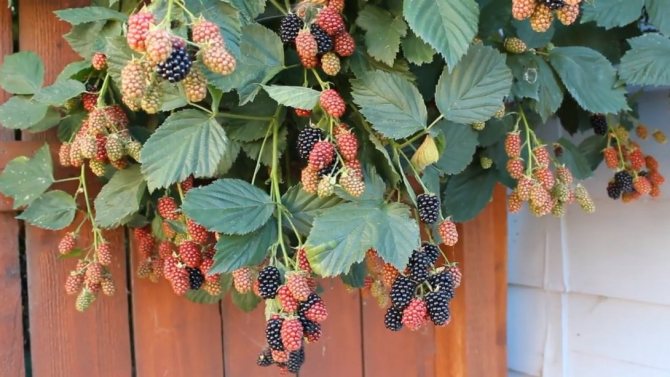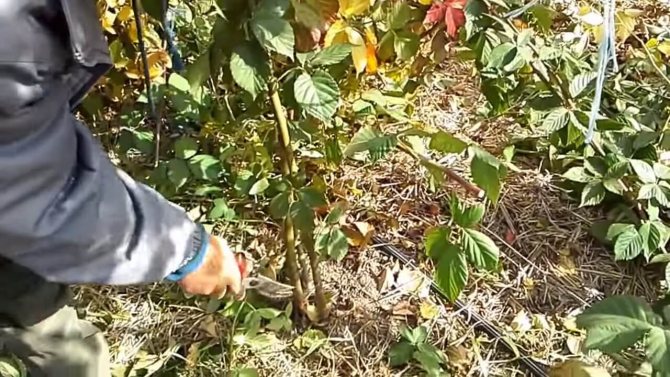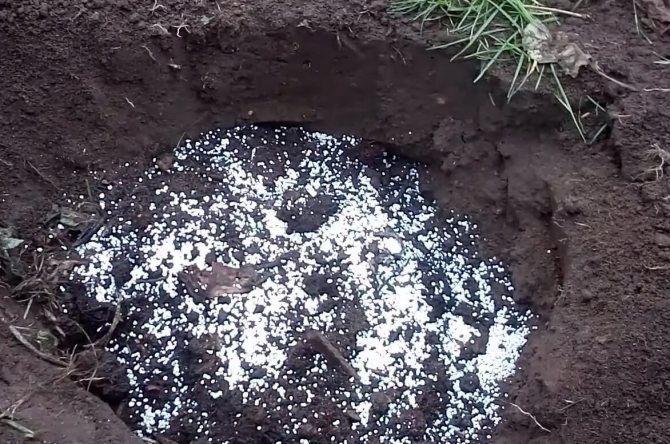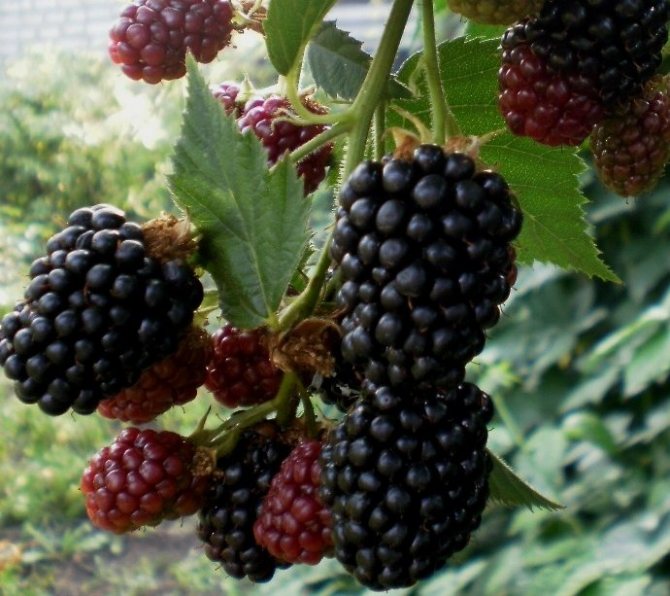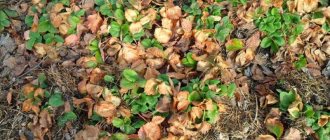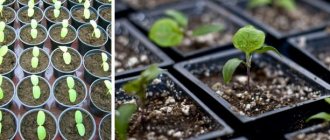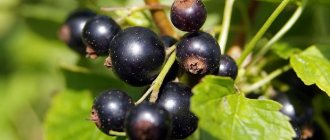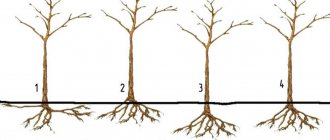Blackberry is a berry of unusual beauty! And how many vitamins it contains, how useful it is! Everyone knows its antipyretic and anti-inflammatory properties. Blackberries are bright, juicy, and you just want to pick and eat them. But for this, the berry must first be grown.
Ripe berries weigh about seven grams and ripen well in the sun. High fertility can be achieved only with proper care.
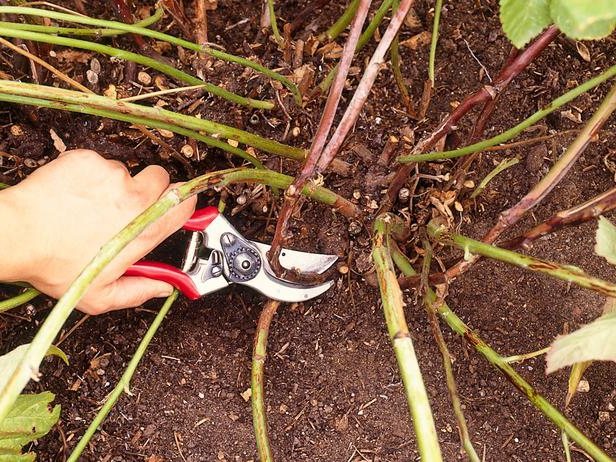
When is it more correct to plant a garden blackberry - in summer, autumn or spring? Timing selection
The yield and benefit potential of blackberry fruit is much wider than that of its closest relative, raspberry. However, gardeners do not seek to plant and grow this magnificent shrub on their site.
This is distinguished by the fact that plant varieties derived from southern forms have been cultivated for a long time. They found it difficult to take root in the planting region and led to massive disappointment of gardeners.
The situation changed after new relatively winter-hardy varieties have appeared, which are able to withstand temperatures as low as -30 C.
Therefore, for cultivation in the middle lane or more northern regions (in Siberia and the Urals), it is important to acquire varieties of modern selection.


To grow blackberries in the middle lane or more northern regions, you need to purchase varieties of modern selection
In spite of this, in the northern regions, the cultivation of blackberries is somewhat limited... This is due to uneven fruiting, the final period of which often coincides with the first frost and some of the fruits do not have time to ripen.
In addition, insufficient lighting leads to a loss of quality in ripe fruits.
Planting blackberries in autumn has more benefits and is most optimal in the middle and southern regions. After planting the shrub, a period with a stable and cool temperature will follow, high humidity will promote root development until the soil temperature drops to -4 ° C.
Blackberries very early come out of a state of relative dormancy and shrubs rooted in the fall will immediately begin to develop a vegetative mass.
In the fall, the selection of varieties and seedlings with a fresh root system is much more, and they cost less than the planting material sold in the spring.
Articles that may interest you:
When planting in spring, the plant does not have time to root. due to too rapid warming and the beginning of sap flow, after which the active growth of shoots begins.
A weak root system is not able to provide the necessary nutrition, an increasing vegetative mass. This greatly weakens the shrub and affects the overall development.
Spring planting is preferred in northern regions and if the blackberry variety is characterized by weak winter hardiness.
In autumn, the plant should be planted at least 20-30 days before the first frost, in spring before bud break, when the air temperature rises to + 15 ° C.
For growing in a personal plot planting material must be purchased from reputable nurseries... The best survival rate is distinguished by annual seedlings with two stems, the thickness of which is at least 0.5 cm in diameter.
An important criterion is a formed bud on the roots... The optimum length of taproots is at least 10 cm.
Variety selection rules
This point should also be taken into account in the article.
- When choosing a blackberry variety for autumn planting, remember that it will have to survive a harsh winter, so give preference to winter-hardy varieties.
- Consider future breeding of the variety. After the blackberries begin to bear fruit in full, you will want to propagate the bush. Some varieties are reluctant to give root shoots, so they are planted only with rooted cuttings.
- The studless blackberry will surprise you as harvesting will become much easier.
- Consider the ripening time of the berries.
Today, many varieties have been bred: blackberries without thorns and with them, sweet and sour, round and elongated (examples of varieties: Thornfrey, Aghavam, Black Satin, etc.). Therefore, when choosing a variety, you need to study all the characteristics in advance in order to get the maximum harvest and remain satisfied with the berry.
Preparing a site for planting a seedling: where is it better to plant, in the sun or in the shade?
For growing blackberries you need to choose a place well lit by the sun and protected from northern winds... In the shade, young shoots of the plant will grow poorly, stretch out, the fruits become smaller and lose their taste.
A good option is planting along a fence, where the shrubbery will be protected from the winds and the stems from breakage. In this case, you need to retreat from the fence by 1 m so that the plant does not get too shaded. The shrub is best located on the southern or southwestern side of the site.
To plant blackberries, you need breathable and well-drained soil. Loams are ideal with a humus layer of at least 25 cm.
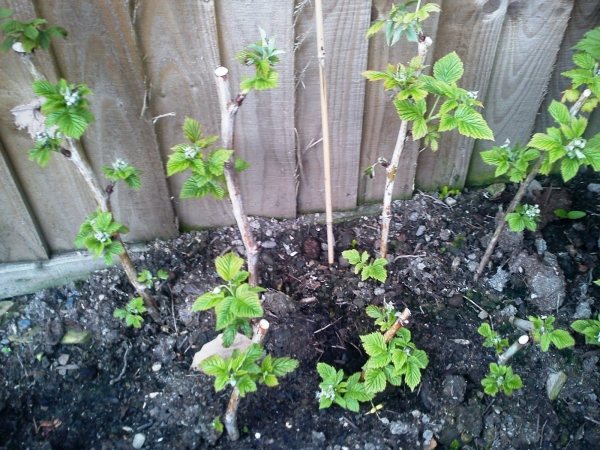

For planting blackberries, choose well-lit areas, loamy, well-drained soils.
The occurrence of groundwater at the site should be no higher than 1.5 meters. If these indicators are violated, the roots of the plant will be damp and cold, which significantly affects winter hardiness and yield indicators.
To plant a thorny shrub, a planting site must be prepared in advance. All weeds are removed, plant waste is destroyed, preventive spraying is carried out against pathogens and pests.
For growing blackberries saline, rocky, sandy and swampy areas are not suitable.
Severely depleted soils need to be nourished with essential macronutrients. For this, the site is dug to a depth of 30-35 cm, organic and mineral fertilizers are applied.
Seat selection
For planting blackberries with seedlings, it is important that the earth is well warmed up. Therefore, autumn is the optimal season for planting a plant. The most favorable months for gardening with this crop are September and October (before the first cold weather).


To plant blackberries correctly in the fall, you need to find the best place for them. She needs a lot of sun, so you should choose an area that is well warmed by the sun's rays, not shaded by buildings and tall trees. It must be protected from strong winds, and not located in a low area where water can accumulate.
The blackberry will need a support (trellis). If for a straight-growing shrub it is only desirable, then for a creeping one it is obligatory. In the place where the blackberry will be planted, it is necessary to place a standard trellis made of pipes, wooden or concrete posts.


Also, a fence (located not on the north side) can serve as a support for the shrub. In this case, a hedge is formed from blackberries, which will become a beautiful decorative element of the garden. Since the blackberry bush is large enough, it must be planted about 0.7-1 m from the fence.
Trellises must be installed before planting, and seedlings should be planted along them. In the spring, the shoots will begin to grow very quickly, so they will immediately need support.
How to plant in open ground
Planting pits and substrate are prepared in 15-20 days before planting seedlings in open ground.
The blackberry root system is more powerful and penetrates deeper than other berry crops. Therefore, the pits need to be made more voluminous. The best way - adhere to parameters 40x40x40 cm.
Organic matter and minerals need to be added to each hole:
- compost or humus 5 kg;
- superphosphate 120 g;
- potassium sulfate 40 g.
The nutrient components are mixed with fertile soil and the resulting substrate is poured into the pit by 2/3 of the volume.
The shrub is planted vertically with a deepening of the root collar 1.5-2 cm... In light sandy loam soils, they are buried up to 3 cm.
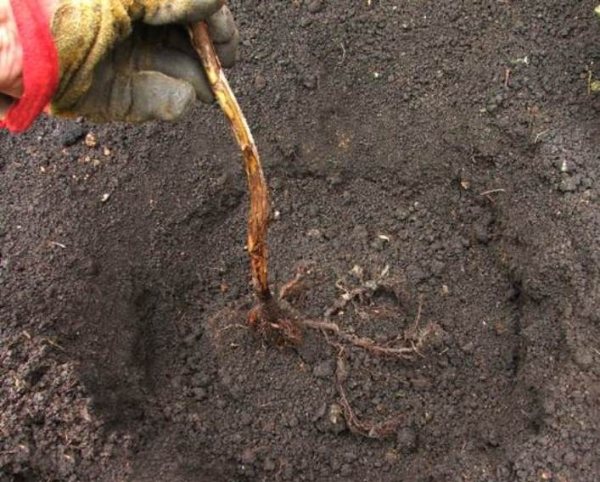

The blackberry is planted vertically with a deepening of the root collar of 1.5-3 cm, covered with a substrate and watered
Blackberry roots are placed in a hole, straightened and covered with a substrate. In this case, the hole is not completely filled, leaving a distance of 1-2 cm to the soil level.
In this way, there will be a notch under each bush, which will contribute to the rational hydration of blackberries.
Then the surface of the substrate must be compacted and water the seedling with 5-6 liters of water... After the spring planting of blackberries, the plant must be provided with regular watering for 40-50 days. After compaction of the soil, the trunk circle is mulched with sawdust, peat or straw.
Planting blackberries:
How to choose seedlings for planting in the fall
Before planting blackberries, you must select the appropriate planting material. Frost-resistant varieties are best used for areas of central Russia and Siberia.
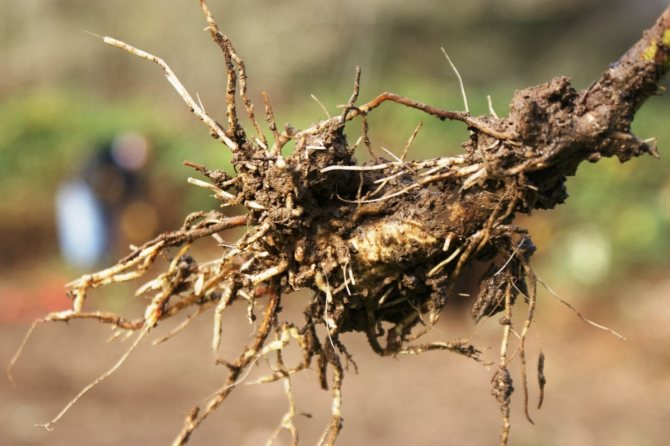

Blackberry root system
Instructions for choosing seedlings include several mandatory points:
- Determining when you plan to plant blackberries.
- When studying the description of a variety, it is important to pay attention to the recommended growing area.
- For cold climates, it is better to purchase erect or semi-creeping varieties of this culture.
- Thornless varieties are much more convenient to grow. Also, caring for this species is more convenient and easier.
- Repairing varieties do not require special care and are much less likely to get sick. The immunity of the hybrid plant is much higher.
- Ordinary representatives of the species, during the formation of berries, are extremely demanding of care and timely feeding.
- When purchasing a seedling, it is important to pay attention to the tendency to shoots.
On a note. In order to determine how to properly plant a thornless blackberry in the fall, it must be remembered that the reproduction of such species is carried out only by stem cuttings. Root suckers will grow into a normal thorny bush.
As a result, a young bush must meet the following qualities:
- age 1 year;
- the root system is developed and has 2-3 shoots;
- it is recommended to buy a plant in a special container.
The golden rule of grooming is pruning
Throughout the life of a blackberry you need to control the density of the bush and make formative pruning.
These activities include:
- Removing inflorescences in the first year of growth... This is done to stimulate the development of the root system.
- In the second year after planting, you need to shorten the stems., leaving a height of 1.5-1.8 m. The procedure is carried out in the spring before bud break. The sections should be made over the kidney.
- Frozen areas should be cut off after each winter. stems to a living bud.
- In the summer, at the beginning of June, the shrub is thinned out... At the same time, young shoots are removed, leaving an average of 6-8 strong stems for creeping varieties and 4-5 for erect ones. The tops of young shoots are cut off by 5-8 cm.
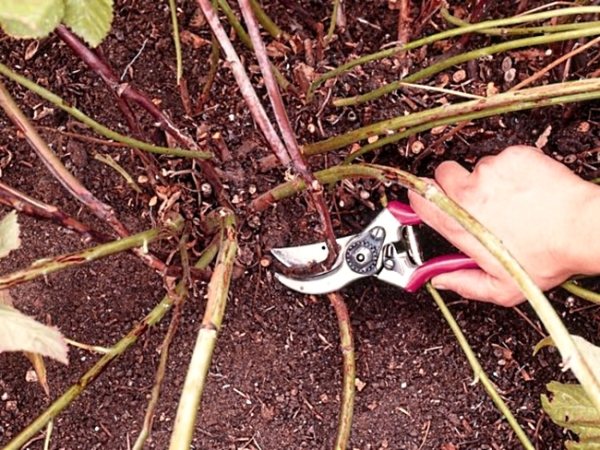

Pruning is necessary for blackberries: this is how the density of the bush is controlled and the stems frozen during the winter are removed
Shrub blackberry - shrub with a two-year fruiting cycle... In the first year, the stems of the plant develop, woody and form fruit buds. The next year they bear fruit and only in rare cases can they form new fruit buds.
Agricultural technicians advise removing biennial shoots, thereby stimulating the development of new growths and thinning the crown of the blackberry, it will only look better from this.
Preparation of supports
Without supports, the bushes turn into solid impassable thickets.When is the best time to install? In order not to damage the seedlings, the supports are dug in before the main planting, metal, wooden or reinforced concrete poles are prepared (wooden ones are cleaned of bark, processed with means that prevent decay).


Photo:
The construction of the supports must be reliable. Therefore, the optimal distance is chosen - 1.5 meters between the posts (in a row) and 30–40 cm between rows to create a garter of shoots of different ages. They are buried in holes 50–60 cm deep, a wire is pulled between the posts, it becomes a support for the shoots.
Thorn bush garter
For creeping shrub species, you will need a trellis with 3-4 rows of wire with a distance of 50 cm between them.
In the first year of development, 2-3 shoots are fan-shaped to the lower wires. Annual shoots are directed to the center of the bush, tying them to the uppermost wire.
Before the onset of cold weather, young shoots are removed from the support and make a shelter for the winter.
Stems of erect blackberry varieties tied to a trellis with a slight slope to one side. When new shoots grow during the growing season, they also need to be tied up. This time, the slope is made in the opposite direction from the fruiting branches.
Fertilization and top dressing are the key to a good harvest
Blackberries need feeding every spring. nitrogen fertilizers that will stimulate the growth of annual shoots is another golden rule. To do this, 50 g of ammonium nitrate is introduced under each bush, embedding it to a depth of 10-15 cm.
Every 3-4 years, the shrub in the garden needs to be fed and other macronutrients. This procedure is carried out after harvesting. At the rate of 1 m2, the following is introduced into the soil under the plant:
- compost or humus 10 kg;
- superphosphate 100 g;
- potassium sulfate 30 g.


Blackberries need feeding with ammonium nitrate, superphosphate, humus
It should be remembered that nitrogen fertilizers are applied only in spring... Also, this mineral is found in large quantities in pig manure and chicken droppings.
Blackberry fertilization activities can be combined by spraying with 1% bordeaux liquid, which will inhibit the development of microorganisms. For additional prevention of diseases, the area under the bushes must be cleaned of fallen leaves.
When to water, do you need to loosen?
Deeply buried, in comparison with other berry bushes, the root system of the blackberry makes the plant drought tolerant... But this does not mean that the plant should be left without irrigation and not watered.
Watering is especially needed during the period of fruit filling. and when hot weather is established. At this time, the wide leaf plates of the plant evaporate a large amount of moisture.
Several times during the growing season you need to loosen the soil under the bushes to a depth of 10 cmwhile removing weeds.
It is especially important to carry out the procedure in the fall, at the end of August, in September. The looser the soil, the less the soil will freeze through in the root layers.
Shelter for the winter time
The shrubs will need shelter before the winter season. For this plant stems are bent to the ground... It is important to do this until the air temperature drops to -1 ° С. Otherwise, they will lose elasticity and break.
To do this, the branches are tied into bunches, bending to the ground and fastening with hooks. Erect blackberry varieties are difficult to bend without breaking the stems.
Many gardeners have found a way out and at the end of the growing season, weights are tied to the tops of the stems, under the weight of which they gradually bend to the ground.
Regardless of the characteristics of frost resistance, all blackberry varieties need shelter for the winter... To do this, you can apply:
- hay or vegetable tops;
- roofing material;
- sawdust;
- peat or humus.
Shelter for blackberries for the winter:
The most dangerous time for blackberries is the snowless beginning of winter.... Therefore, it is necessary to cover the plant before the onset of the first cold weather, and in winter to pull snow to it. Blackberry stems are not prone to podoprevanie, so the plant can be covered with polyethylene.
The foliage of fruit trees is not suitable as a covering material. Pathogenic microorganisms are often hidden in it, which in the spring can begin active development on the bush.
Fruiting blackberries unevenly and can cover a whole month. Shrub fruits are distinguished by good transportability and long shelf life at low temperatures.
Leaves and roots of the plant possess bactericidal, sedative properties and will take a worthy place in the home collection of herbal remedies.
Blackberry is a berry of unusual beauty! And how many vitamins it contains, how useful it is! Everyone knows its antipyretic and anti-inflammatory properties. Blackberries are bright, juicy, and you just want to pick and eat them. But for this, the berry must first be grown.
Ripe berries weigh about seven grams and ripen well in the sun. High fertility can be achieved only with proper care.
Reproduction technology of adult blackberry plants in autumn for planting
It is important to decide on planting, when and how to plant blackberries in the fall. Landing is carried out according to generally accepted rules:
- The hole should be at least 10 cm larger than the root system. Planting the plant in tight holes is not recommended, since blackberries are demanding on growing conditions.
- The bottom layer should consist of humus. Organics are the best feeding helper.
- It is recommended to plant blackberries in the most nutritious soil, with an average pH level.
- After planting, the soil is compacted and watered. Experienced gardeners advise adding fertilizers containing potassium to the water. This will allow you to grow the strongest and healthiest plant possible.
- Mulching under a bush is best done with plant residues.
Important! Mulch plants should not contain seeds, otherwise new weeds will appear.
If you want to propagate blackberries, the easiest way is to carry out the procedure using side layers. Gardeners are advised to do this in the middle of autumn. Lateral healthy stems must be bent to the ground and secured with any hairpin or wire. Rooting takes place throughout the fall and winter. At the end of spring, the seedling is separated from the adult plant and transplanted to a prepared place.
Description and types of blackberries
There are many types and varieties of these berries.
According to the method of stem growth, two types are distinguished - erect (kumaniks) and creeping blackberries (dews). In terms of yield, mildews are more valuable than kumaniks, however, their creeping shoots make the growing process more laborious and costly.
Kumaniki have stems growing vertically, some of them are slightly drooping ashy color. Their height is about three meters. Young plants grow from buds placed on the roots. Usually these are thorny, winter-hardy forms. Kumanik flowers are self-pollinating. The fruits are large, distinguished by their brilliance.
Rosyaniki have oblong creeping stems with fruit branches placed perpendicularly. The presence of thorns is determined by their variety and type. It is from the dews that the thornless varieties of blackberries are produced. Fruits are black or dark red in color, very large, juicy and have gained primacy in taste among the berries of erect varieties.
Consider the popular varieties of blackberries:
- Agave - the most frost-resistant variety. Survives even in 40-degree frosts. Plants have tall, arched shoots with strong thorns. The berries weigh about three grams, black, sweet with sourness, insanely fragrant. Ripening begins in August. One bush can please you with four kilograms of berries. The variety is resistant to disease.
- Darrow - is also a fairly persistent and high-yielding variety, tolerates 30-degree frosts.The bush is large, the shoots are straight, covered with thorns. The berries weigh up to four grams, their shape is conical, the color is black, shiny, the taste is slightly acidic.
- Wilsons Earley - one of the varieties that delight with an early harvest. The fruits begin to ripen in July. It tolerates frost relatively well. Shoots are straight, drooping in places, with medium-sized thorns, reaching up to two meters in height. The berries are small, black with a purple tint, egg-shaped, weighing about two grams.
- Lucretia - creeping variety. The bush is large, strong, with a huge number of shoots covered with thorny thorns. This variety is not winter-hardy at all, it lends itself to infection with diseases. Its advantage is large berries that ripen early.
- Abundant - a high-yielding variety. It has a large bush with elongated shoots. They creep along the ground and are covered with curved thorns. The berries are large, weigh up to ten grams, sour, ripen late.
Choosing a landing method
When deciding how to properly plant a blackberry in the fall, it is necessary to take into account the method of growing a fruit crop.
The following methods are in demand:
- planting seedlings;
- cuttings;
- cultivation of shrubs with seeds, lignified offspring;
- propagation by root cuttings or apical layers;
- division of bushes.
If the dacha is located in the Moscow region and the central part of Russia, you can grow the following blackberry varieties:
- Agave - the variety is highly frost-resistant. The culture has a bush crown, grows up to 3 m. The crop ripens in July-August. The berries of the variety have sweet pulp, weight - up to 5 g. From 1 bush, you can collect up to 6-10 kg of berries. The shoots will need to be pruned regularly.
- Polar - the variety has no thorns and is resistant to temperature drop. Bushes grow up to 2.5 m. Harvest ripens early. The berry weight reaches 12 g, up to 6 kg can be harvested from 1 bush. The shrub does not need to be closed during the winter.
- Natchez is an early ripe variety, the harvest is harvested in June-July. The berries of the variety are large, weighing up to 12 g. The variety belongs to high-yielding, up to 20 kg are harvested from 1 bush. The shoots are semi-erect, stretching up to 3 m in height. For the winter, the bushes are covered with agrofibre. The shelter is removed after stable warm weather.
- Chester - the variety belongs to frost-resistant, but takes cover before the winter period. The crop is high-yielding, up to 20 kg can be harvested from 1 bush. The weight of the berries is 8 g. The species is late-ripening, the berries begin to ripen not earlier than late July-early August. The bushes are thornless, the shoots stretch up to 3 m.
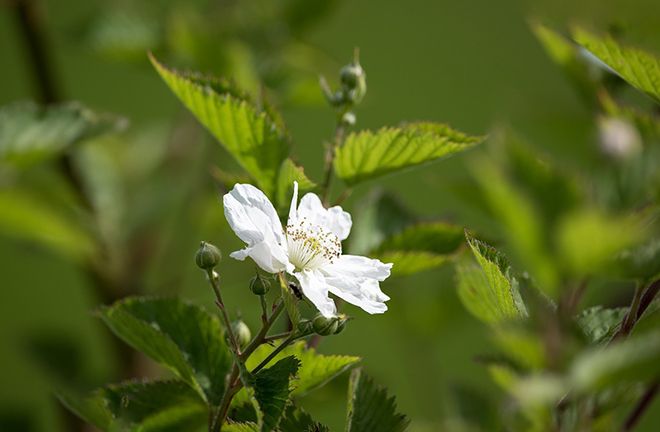

- The thornfree blackberry variety belongs to the thornless, high-yielding, berries have good taste characteristics. Branches semi-adjacent to the ground stretch up to 4-5 m. The diameter of the bushes can reach 200 m. The shoots of the plant are dense, with textured leaves.
- Thornless is distinguished by liana-shaped branches up to 5-7 m long. The bushes can be planted along the fence and form a hedge. The berries are large. The variety belongs to the prickly hybrid varieties.
- Tayberry grows in the form of spreading shrubs, has long branches with dark green foliage. The culture is recommended to be fed with mineral compounds and mulched with compost. Plants stretch up to 3-4 m, it is necessary to put supports under the branches. The berries grow up to 5 cm in length. After picking the berries, you need to prune the branches for the winter.
- The Wilson Earley variety belongs to the early maturing. The berries ripen by July. The fruits are distinguished by a rich purple-black tone, the weight of the berries is up to 2 g. The shoots are straight, as they grow, they bend slightly and need a garter or support. The plant is resistant to pests, diseases, belongs to frost-resistant species. Shrubs grow on loamy soils.
- Darrow belongs to the upright blackberry species. The fruits have a sour-sweet taste, the weight of the berries reaches 4 g. The shoots are prickly, they stretch up to 2.5-3 m. The harvest ripens in August, the berries continue to ripen for 1-1.5 months.The culture is planted on trellises, it is recommended that the lashes create supports. The productivity of the bushes is gradually increasing and reaches 10 kg from 1 bush. In the first place, the variety can be grown up to 7-10 years. The variety is frost-resistant, disease-resistant ..
- Flint is frost-resistant, can withstand temperatures as low as -35 ° C, and is resistant to diseases and insect pests. Erect bushes are formed from branches that grow up to 3 m. Fruits are round, weigh up to 5-7 g, the flesh is sweet. The species belongs to high-yielding, up to 10 kg are harvested from 1 bush. Fruits begin to be harvested from mid-July. The plant grows well on loamy soil, unpretentious in care.
- The local Ufa blackberry belongs to frost-resistant species. The culture is high-yielding. The berries weigh up to 3 g, the pulp has a sweet-sugar taste. The culture is planted in lighted areas, on fertile soil. The blackberry variety is resistant to diseases and insects.
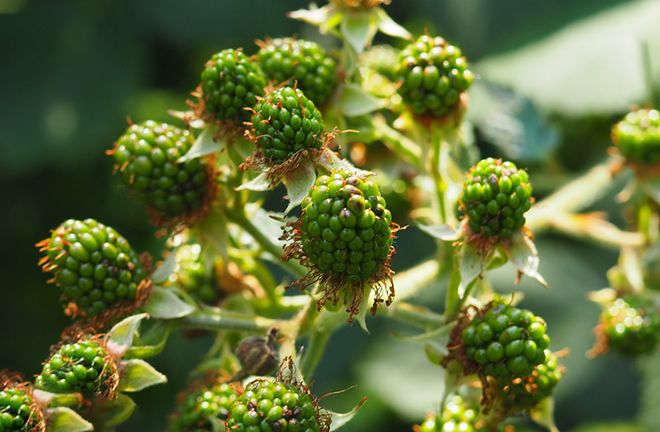

Saplings
Before planting seedlings, it is necessary to choose a planting material suitable for the climatic conditions of the region. Experts recommend to be guided by the following requirements for seedlings:
- for planting, zoned crop varieties are selected, adapted to the climate of the region;
- for central Russia, varieties with frost-resistant characteristics are selected for good survival;
- it must be borne in mind that erect and semi-creeping varieties are more frost-resistant;
- varieties have low or high shoot formation, seedlings are selected in accordance with the characteristics of the site, the skills and needs of the gardener;
- a seedling grown for 1 year should have 2-3 shoots, the thickness of which is not less than 0.5 cm;
- there must be a formed bud on the root system of the plant;
- the roots should be well formed, there should be no mold, mechanical damage, rot on the roots;
- it is recommended to choose seedlings with a closed root system (in a container for planting with a lump of earth) to increase the survival rate of the bush;
- it is recommended to buy planting material from specialized horticultural departments.
Before planting in the soil, the grown seedlings for preventive purposes and to improve the condition of the root system must be dipped into an aqueous solution. The composition is prepared at the rate of 1 tsp. hydrogen peroxide (6%) per 1 liter of water. The roots are kept in solution for 10-15 minutes.
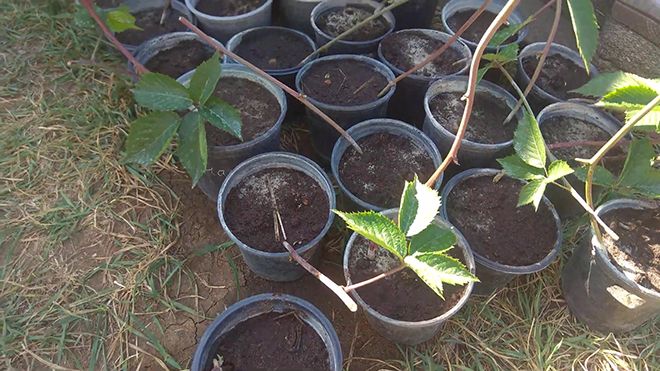

When placing seedlings, the requirements of gardeners for the required area for the development of the bush and the planting scheme are observed. For bushes that grow and have shoots up to 4-5 m, thickening of the plantings is not allowed. This can lead to a decrease in the area of soil and root nutrition, a decrease in yield, a lack of the necessary illumination by the plant, and difficulty in pruning and caring for bushes.
When planting single bushes, a distance of up to 2 m is left next to each side of the planting recess. Before buildings and fences, it is necessary to maintain a space of at least 1.5 m.
Bushes can be planted in rows, the distance is determined by the characteristics of the blackberry variety:
- Straight-growing varieties are placed with an interval in a row from bushes of 1.5-2.5 m; a space of at least 2 m must be left between the rows of shrubs.
- Creeping and semi-creeping varieties are placed with an interval in a row of about 2.5 - 3.0 m.At least 2.5 m is left between the rows.
- An increased planting density of bushes (40-45 bushes per 1 hundred square meters) is allowed only with large volumes of fruit bushes growing and the use of effective fertilizers, organization of drip irrigation, etc.
Cuttings
Gardeners have developed the cultivation of blackberries with stem and root cuttings.


When using root cuttings, it is recommended to observe the following requirements:
- The roots from the main bush are dug up in the fall, cut into cuttings up to 5-7 cm long.The optimal roots are 1-3 years old, the thickness of which reaches 0.7 cm.
- When harvesting planting material in the autumn, the cutting is placed in a box with moistened sand and placed in the basement.
- Root petioles are planted immediately in a prepared place.
- For planting, grooves are cut at intervals of 70-80 cm, the depth of the furrows is 10-12 cm.
- Cuttings are laid out at intervals of 20 cm and covered with loose earth, then watered with water.
It should be borne in mind that the root cuttings method is used only for varieties with thorns. For breeding thornless varieties, stem cuttings are used.
When using root cuttings of thornless varieties, bushes with thorns on the branches can grow.
Breeding with stem cuttings is carried out subject to the following step-by-step plan:
- It is necessary to prepare cuttings from annual shoots (the upper part of the branches). On a 15 cm long handle there should be 2-3 buds and leaves.
- The leaves are cut off from the cuttings, the branches are placed with the apical bud in a container with water.
- The stalk is in the dish until the roots form and the development of a small plant with shoots.
- The seedling is removed and placed in a bowl filled with light nutrient-rich soil for growing seedlings. A mixture of perlite and peat or a combination of sand and vermiculite in a 1: 1 ratio is optimal.
- The plant is grown at home or in a greenhouse.
- The roots will begin to appear on the cuttings after 1-1.5 months. After that, a transfer to the site is allowed.


A story and video on how to properly care for a blackberry
Even a novice gardener can learn to plant, grow and propagate blackberries, since this culture is not demanding on conditions, and the most necessary thing to know about it, we will tell you in this article.
Pick-up time
Spring and autumn conditions are suitable for planting blackberries. In the spring, it is recommended to do this early, while the buds have not yet begun to grow. And in autumn, the best option would be the end of September - early October, that is, no later than 3-4 weeks before the onset of frost. Experienced gardeners recommend planting blackberries in the fall, but you need to be especially careful when choosing planting material: if you plant an unripe plant, it will not take root. Maturation is easy to determine - large replacement buds are visible on the root collar. The ripening time depends on the variety: the early ones are ready by mid-September, the late ones by the end, or at the beginning of October.
Autumn planting time is preferable to spring, since in spring the soil quickly dries up as a result of the establishment of hot weather, and in autumn the air temperature is much cooler, which contributes to the rapid growth of new roots.
Site selection and soil preparation for planting in the fall
Before planting a blackberry, you need to familiarize yourself with its requirements:
- Blackberries are very light-requiring. She will delight her owners with high yields only in the sun or in partial shade. The consequences of a lack of sunlight will be small berries and a deterioration in their taste. Young stems in the shade will stretch strongly upward, closer to the sun's rays, shading the fruiting shoots.
- This culture does not tolerate excessively wet soils. It does not hurt to take into account the depth of groundwater, they should not be closer than 1 meter.
- It is important to remember that not all blackberry varieties are hardy. Therefore, the plantation must be well heated and protected from drafts and strong winds.
For blackberries, it is better to choose loamy soils, rather than calcareous ones. Thus, the plantation for growing blackberries should be light, not wet, protected from the winds.
If you decide to place the bushes along the fence, then it is better to move from it by half a meter - a meter, and the row spacing should be one meter. Thus, the plants will be less in the shade, and it will be much more convenient to harvest.
The soil must be enriched with useful substances and free from all kinds of weeds and parasites.Before planting blackberries in the fall, the plantation is fertilized with rotted manure, phosphorus and potassium.
Soil processing and preparation
After choosing a place for growing blackberries, it is necessary to properly process and prepare the soil. A plantation with a flat surface, closed from cold winds, must, first of all, be cleared of weeds, and pests must be destroyed. After that, top dressing is applied.
Rotted manure, superphosphate and potassium phosphate are ideal. If the soils are rich in humus, then it is not necessary to fertilize with organic matter. It is advisable to plow the land to a depth of 40-50 centimeters, and it is advisable to level the soil before planting.
In the future, every autumn it is necessary to plow the land in the aisles up to twenty centimeters deep. In the rows where the main number of roots is located, you need to carefully weed the weeds so as not to damage the roots of the blackberry, if necessary, remove excess offspring.
In order not to hurt the rhizomes, it is better to use a pitchfork. Until the time when new shoots begin to germinate, it is necessary to cover those areas with organic matter where the main roots are located.
Open ground planting process
For planting blackberries in the open ground in the fall, it is better to purchase annual seedlings with a sufficiently developed root system, two shoots, at least 50 millimeters thick and with an already tied bud on the roots. These are the main requirements.
The parameters of the pit depend on the quality and age of the seedling. It is better to plant a shrub at a distance of at least a meter from other plants or outbuildings. The distance between the bushes varies depending on the shoot-forming qualities of the variety and the method of planting the blackberry.
You can use the tape and bush method. If the seedlings have a low level of shoot formation, then it is better to give preference to the bush method (several seedlings sit in one hole).
If the seedlings are vigorously forming shoots, then they are immersed in a belt method (one after another every meter).
When the bush descends into the hole, it must be spread out the roots and covered with earth in such a way that the bud is two to three centimeters above ground level. In this case, it is desirable to form a hollow for the convenience of watering.
Blackberry pruning
Blackberry is a shrub that has a development cycle of two years. Therefore, in the fall, the bushes are pruned in order to get rid of damaged and fruiting shoots, since the harvest from them is no longer worth waiting for.
And also extra young shoots and, not sufficiently ripe, thin and short stems are removed.
The first pruning is carried out in late summer or autumn two years after planting, and then it is carried out regularly once a year. Solid, ripe young shoots are shortened by about a quarter. Having analyzed the strength of root growth, we calculate the future load of the shrub.
An average bush is able to provide six to eight fruiting stems with useful elements in sufficient quantities. Therefore, it is better to leave about ten shoots for the winter to play it safe in case not all the stems survive the winter.
Blackberries are a close relative of raspberries and their development cycle is the same, that is, fruiting shoots develop for two years. In the first year, annual shoots grow from the rhizome, and the next year a crop is formed on them, after harvesting these shoots must be cut off at ground level. Instead of old shoots, new ones appear, and the earlier the pruning of fruiting shoots is carried out, the stronger the young will be, since only they will get food and moisture.
Top dressing
Regular feeding of blackberries will significantly improve yields. In the spring, five to eight kilograms of compost or humus and fifty grams of ammonium nitrate are introduced under each shrub. In early summer, the shrubs are fertilized with a mullein solution.
It is diluted with water in a ratio of one to five.You can replace it with diluted bird droppings (ten parts of water for one part of droppings). Or you can simply sprinkle the top layer of soil with Agrolife. After harvesting, the blackberries are fed with wood ash and superphosphate. Will benefit the mulching of the soil with organic matter.
Watering
Blackberry is a completely drought-resistant shrub. This is due to the fact that its roots reach considerable depth. It especially needs moisture during the period of flowering and ripening of berries. But it is better to adhere to the norms, since excessive moisture can cause the death of the plant.
Formation of bushes
- There are three rows of wire to be pulled. Shoots twine between them. All shoots that grow back after formation are divided to the right and left from the base of the bush, leading to the fourth row of the drip. It is pulled above all the rows.
- Blackberry shoots are distributed and fixed in the form of a fan. Healthy and young stems are attached to the topmost row of drums. This method allows the shoots to grow more freely, they are better lit. By these measures, a larger yield is achieved. This method requires more labor and time than the first.
- Fruit shoots are distributed in different directions from young shoots and attached at a height of about a meter to a horizontal wire. You can attach something soft (rope, braid, twine).
Planting blackberries in autumn with seedlings. Schematic secrets of planting
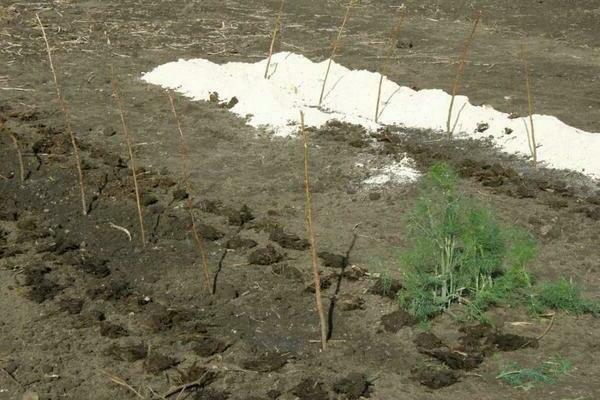

When you choose varieties with powerful development and root system for your garden, be sure to keep in mind that you cannot thicken the plantings. In this case, blackberries develop poorly, the amount of harvest decreases, and the bushes themselves become more vulnerable to pests and diseases. This applies to bushes that can grow up to 5 meters.
What else minuses arise close fit:
- the area of plant nutrition is significantly reduced;
- lack of sunlight, affects the quality of the solidity of the stems;
- for plantings, seasonal care is complicated: loosening, weeding and other actions;
- diseases often occur that are not characteristic of the bushes with proper care, the quality and quantity of the crop decreases.
It is advisable to choose a single scheme for planting a plant. At the same time, the distance between the bushes remains at least 2 meters, in all directions from the base of the planting pit. All buildings can serve as a good shelter from strong winds, but keep the distance between the plant and the building, at least 150 centimeters.
For a comfortable location of tall bushes, when using a trellis, it is recommended to plant the plant in convenient rows. The choice of a certain distance always depends on the varietal characteristics of the blackberry, that is, on the growth of the bush. We also calculate the distance depending on the created support and the rules of agricultural technology for such crops.
Growing upright species, in particular remontant
Most upright shrubs are remontant varieties. For them, we calculate the distance as follows: between the bushes from 150 to 250 centimeters, leave the distance between the rows up to 2 meters.
Creeping and semi-creeping shaping
If we consider varieties of creeping and semi-creeping species, we calculate the distance as follows: between plants - up to 3 meters, but not less than 250 centimeters, row spacing - not less than 250 cm.
Uterus
When creating a mother liquor, we observe the following system: the distance between plants is not less than 300 centimeters, the row spacing is also not less than 3 meters.
Agricultural technology of industrial planting
With the industrial planting of blackberries, special conditions are necessary, it is necessary to plant a lot of material, and, at the same time, save space. Therefore, the following scheme is observed: we leave up to 1 meter between the plants, the row spacing is observed at least 170 cm and up to 2 meters.
All schematic planting data are calculated with the condition of growing on a private territory and when working with plants manually. For the mechanization of the process, such a schematic is not acceptable.The creation of a higher planting density (up to 45 plants per one hundred square meters) is possible when it is possible to create an intensive process of agricultural technology: drip irrigation, regular, systematic feeding and a number of other measures.
Features of autumn planting of blackberries
Like most berry bushes, blackberry seedlings are best planted at the beginning or end of the growing season when the plants are dormant. The autumn planting method has some advantages:
- for successful rooting, blackberry bushes need warm earth, and in the fall the soil has not yet cooled down after summer;
- prolonged autumn rains allow you not to worry about watering young plants, as there is enough moisture;
- immediately after planting, the plant spends all its energy on high-quality rooting, trying to develop the root system to the maximum, and in the spring it immediately starts to grow;
- the first harvest can be expected next year.
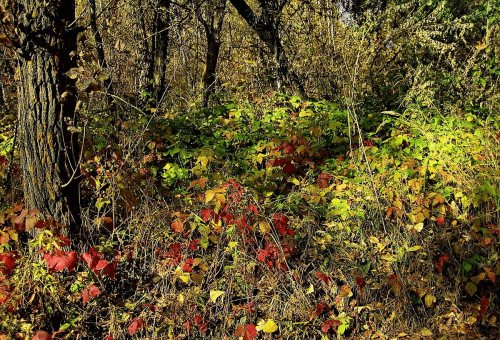

It is better to plant a blackberry in the fall, when the plant goes into a state of dormancy.
A significant disadvantage of the autumn planting of blackberry seedlings is the possibility of freezing in winter.
There are no blackberries on my lot. Although a couple of years ago in the spring I tried to plant a bush. The seedling is well-rooted and has several new shoots. But he did not survive the winter, although the variety was frost-hardy enough and zoned for the Siberian climate. Believing the seller, I did not cover the plant for the winter.
Landing dates
The exact time of planting blackberry bushes strongly depends on the characteristics of the local climate. The main thing is to place the plant in the ground 20-30 days before the onset of real cold weather. The seedling must have time to root well in a new place.
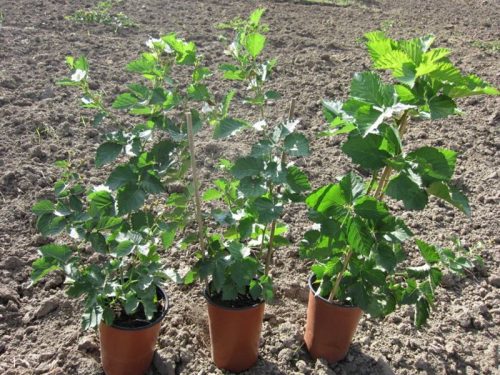

Blackberry seedlings should have time to take root before winter
In the northern regions with harsh climatic conditions, planting is carried out from the end of September to the first days of October. The mild warm climate of the southern regions allows you to postpone this period until November and even until mid-December.
A blackberry bush planted in autumn develops its root system until frost when the soil temperature drops to -4 ° C.
Video: when to plant blackberries
When to plant optimally in different regions
The planting time for blackberries in autumn is determined by the peculiarities of the local climate. It takes 25-30 days to root a bush. Accordingly, about a month should remain before the first frost. Be guided by the air temperature: the most favorable indicator is 12-17 ° C.
Timing for different regions:
- Ukraine, southern Russia - end of October and the first two decades of November;
- Moscow region and the middle zone of Russia - the last decade of September and the first half of October;
- Northwest region - all September;
- Ural, Siberia - end of August and first half of September.
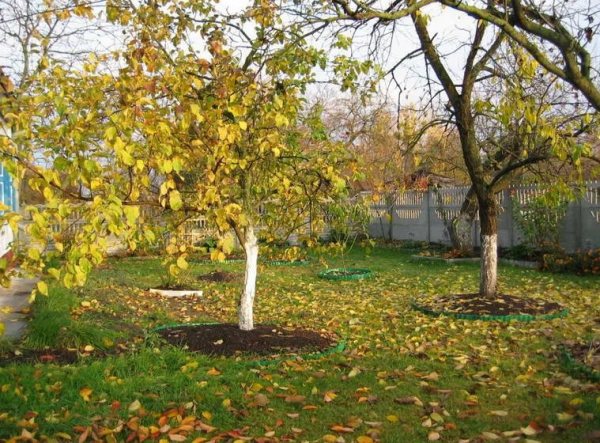

Golden autumn in the garden - the time for planting many shrubs, including blackberries
If you are guided by the lunar calendar, the days of the full moon and new moon are immediately excluded. Root growth is best on the growing moon. Auspicious days for disembarkation in 2020 are 1, 2, 10, 11, 15, 16, 20, 21, 26 October and 1-3, 22, 23, 29, 30 November.
Selection and preparation of a site for blackberries
Blackberries are in dire need of sun and warmth. For it, you need to select the sunniest area, which is protected from cold gusty winds from all directions.... This berry shrub feels very bad and does not really take root in arid places, it needs constant light moisture. But excess moisture, boggy and a close level of groundwater (above 1.5 m) are destructive for the culture.
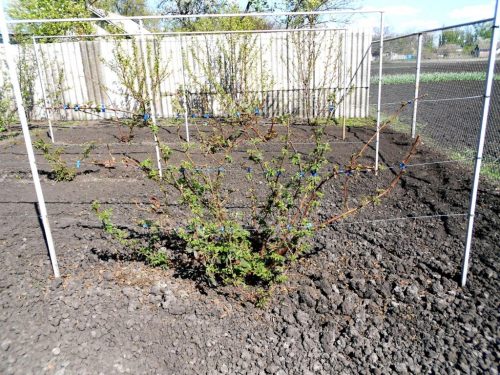

A well-lit place is selected for blackberries.
Best of all, blackberry bushes grow on moisture-intensive fertile rather heavy clay and loamy soils. Even on hot summer days, the earth should hold water well and not dry out. On sandy and stony soils that do not hold moisture well, it will not be possible to get a good harvest.
Heavy clayey calcareous soils rich in magnesium and calcium salts are not suitable for blackberries.
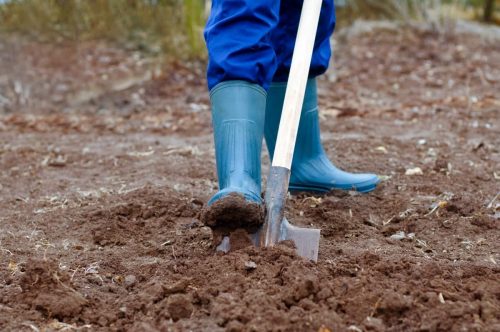

The area for the blackberry needs to be well dug up
Approximately 2-3 weeks before planting, the area intended for blackberries must be weeded out and dug to a depth of at least 0.45–0.5 m, while picking out the roots of perennial weeds. Then, planting pits are prepared with a diameter of about 0.5-0.55 m and a depth of up to 0.5 m. The extracted fertile soil is mixed with:
- humus or rotted compost - 9-10 kg;
- superphosphate - 45-50 g;
- potassium sulfate - 25-50 g;
- wood ash - 100-150 g.
The resulting soil mixture is filled with 2/3 of its volume.
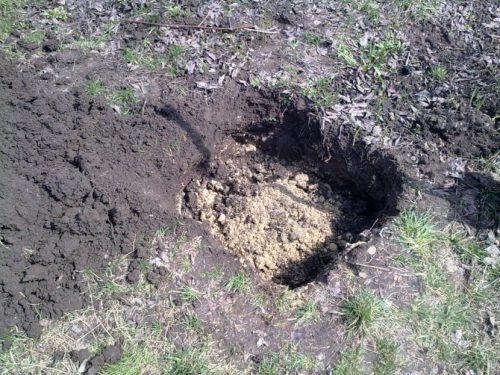

The planting pit is filled with mineral and organic fertilizers
You can add any autumn phosphorus-potassium mineral complexes with a minimum nitrogen content.
Photo gallery: autumn fertilizers for blackberries
Video: preparing a site for a blackberry
Soil preparation
When planning the planting of blackberries in the fall, you need to pay great attention to the soil. Saplings will thrive on fertile, moist (but not waterlogged) deeply drained medium loamy soils. The soil is loosened to a depth of about 0.5 m.
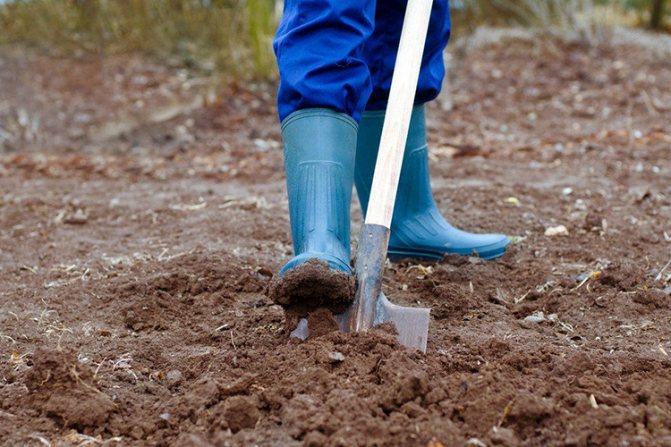

Blackberries cannot withstand poor drainage. Even short-term flooding can completely destroy seedlings and fragile shoots.
The best precursors for blackberries are legumes and cereals, well-fertilized vegetables (beets, carrots, zucchini, cucumbers), green manure. Among the siderates, preference should be given to a pea-oat mixture or mustard. Before planting blackberries in the fall, the site is sown with siderates and during flowering they are mown, embedded in the soil.
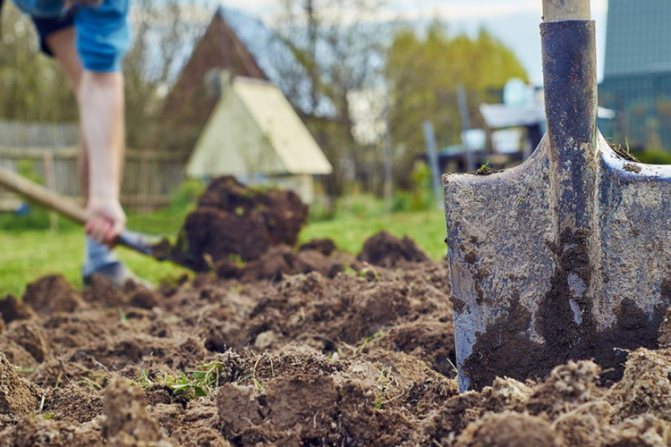

To plant blackberries in the fall, the site must be cleared of weeds and pests, and also well fertilized with nutrients. After harvesting the previous crop, organic fertilizers are applied to the soil: about 2-3 kg per 1 m2. If necessary, add mineral fertilizers: potassium, phosphorus, magnesium, calcium. The site is well dug up.
Ideally, the rules for planting blackberries in the fall require 2-3 years of soil preparation. In this case, organic fertilizers should be applied six months before the start of work, so that they can completely give up their nutrients to the soil. Fertilizers can be applied before planting, but in smaller quantities, and then their effectiveness is reduced by about half.
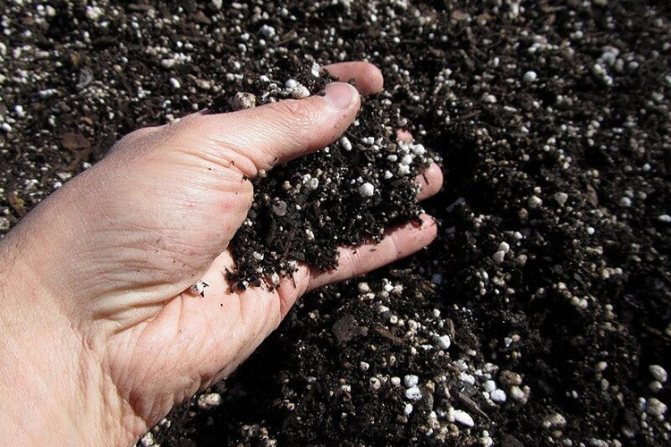

Before planting blackberries, it is necessary to moisten the soil well. It shouldn't be dry, but it shouldn't be too wet either. In the fall, when it is no longer so hot, it is much easier to keep the soil moisture.
Step-by-step instructions for planting blackberries in autumn
Planting work is carried out as follows:
- Water is poured into the pit (5–6 l).


At least 5-6 liters of water are poured into the planting pit
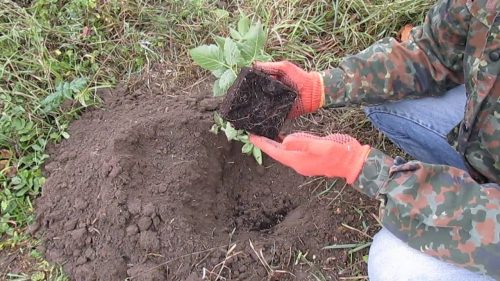

We lower the seedling into the planting hole


The roots should be spread out in different directions
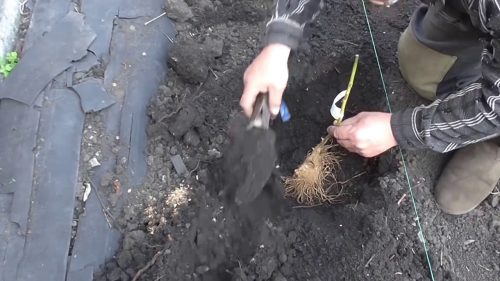

The hole is filled with soil mixture in layers
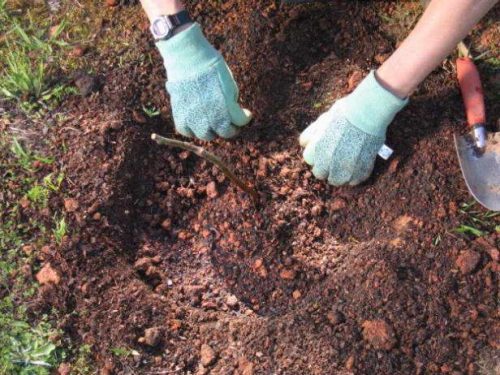

When planting, the ground must be compacted so that no air voids remain
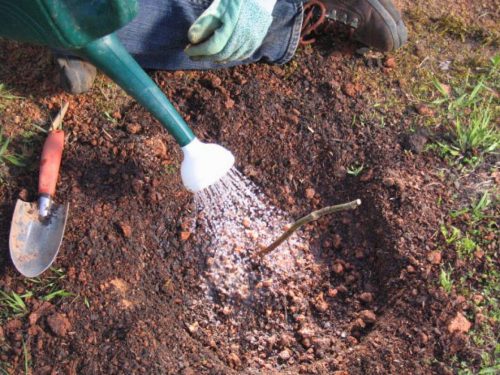

After planting, the blackberry seedling needs to be well watered
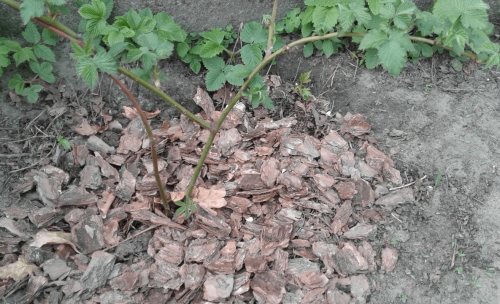

Mulch is poured into the trunk circle with a layer of 8-10 cm
At least 3 m are left between individual specimens, the rows are placed at a distance of about 2 m from each other. When planting blackberries along a fence or building wall, it is necessary to retreat at least 1.5 m, since the bushes grow very much.
Video: planting blackberries correctly
Further care of seedlings
Blackberry care in the fall is minimal. The necessary fertilizers have already been introduced into the planting pit, mulching relieves the gardener from weeding and loosening, pruning the seedling is also not needed. You can even do without watering if the fall is rainy. Otherwise, the plant will have to be watered every 7-10 days, consuming 10 liters of water.
In the southern regions, in order to winter without prejudice to themselves, blackberries usually have enough mulch in the trunk circle, poured during planting. Snow provides additional protection.In central Russia, humus or ready-made compost is poured with a mound of 20-25 cm in height at the base of the bush, and when it snows, they scoop it up to the blackberry.
The most "capital" plants need shelter in the Urals and Siberia. Protect not only the roots. The procedure looks like this:
- The shoots are tied.
- The branches are wrapped with 2-3 layers of any air-permeable covering material (only necessary for large bushes that have been transplanted to a new place).
- Then the blackberry is covered with a special cover or cardboard box, pouring shavings, sawdust, straw, dead leaves inside.
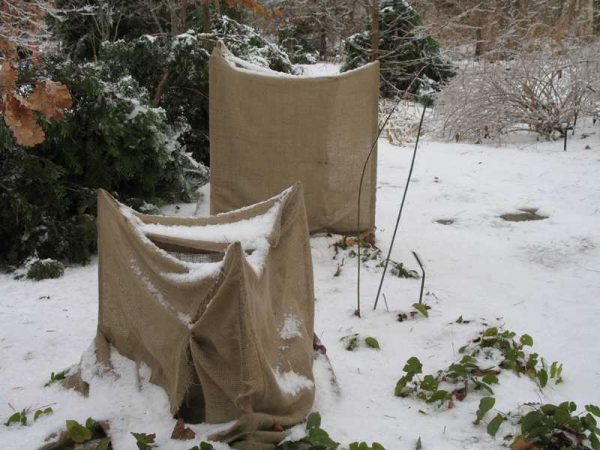

In regions with the most severe winters, not only the roots of the blackberry need protection from frost, but also the aboveground part of the bush.
The shelter is built when the temperature of 3-5 ° C lasts about a week and, judging by the forecasts of weather forecasters, is not going to rise. In the spring, it is removed as soon as it becomes positive - otherwise the shoots will begin to undermine, rot may develop.
Obtaining abundant harvests of blackberries is impossible if you choose the wrong place for the bush, add the wrong fertilizers to the planting hole, and purchase low-quality seedlings. In the very procedure for disembarking in the fall, there are also some nuances that you need to familiarize yourself with in advance.

